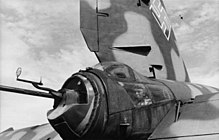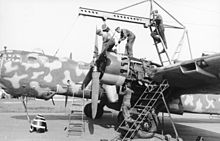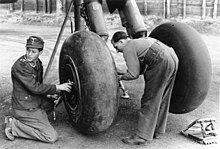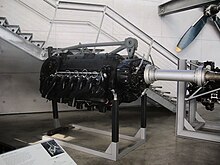Heinkel He 177
| Heinkel He 177 | |
|---|---|
 Heinkel He 177 V5 |
|
| Type: | bomber |
| Design country: | |
| Manufacturer: | |
| First flight: |
November 19, 1939 |
| Commissioning: |
1943 |
| Production time: |
1942 to 1944 |
| Number of pieces: |
1137 |
The Heinkel He 177 "Greif" was a four-engine heavy bomber from the Second World War from German production. What was unusual about this machine from Ernst Heinkel Flugzeugwerke was the engine arrangement with two coupled motors on each side, which drove a common propeller shaft via a gearbox . Double motors of the type DB 606 and DB 610 were used . With its two propellers , the He 177 looked like a twin-engine airplane. With the unusual drive, the machine should be made suitable for fall combat .
development
In 1938 the Reich Aviation Ministry requested a heavy bomber with a long range. Junkers then built the Ju 89 , Dornier the Do 19 . After the first experiences from the Spanish Civil War with the Ju 87 , the RLM under Ernst Udet decided that from now on all German bomber planes should be suitable for dive bombers. The total incompatibility of these two design goals ultimately led to the failure of the design. Originally, Heinkel's design prevailed over its competitors and had many innovative construction features, including motors coupled to one another acting on a common propeller shaft and remote-controlled MG stands. The latter, however, were soon abandoned in favor of manned turrets, which, along with other weighty structural changes (resulting from the intention to swoop this large aircraft), caused significant encroachments on the He 177's original optimistic performance expectations.
When the He 177 was put into service, considerable inadequacies were found. As an extremely fragile machine that its crews did not like to fly, it came into service before serious errors had been rectified. The first prototype was powered by two 2700 hp DB-606 engines (each consisting of two coupled DB-601 engines ) and made its maiden flight in November 1939. However, problems soon arose from overheating engines; the second and fourth machines broke in midair; the engines of the fifth caught fire and crashed the plane. Similar malfunctions in later prototypes brought the He 177 nicknames such as “Burning Coffin”, “Reichsfackel” or “Reichsfeuerzeug”.
Despite their unreliable engines and other shortcomings, work on the pre-series He 177 A-0 and the He 177 A-1 series model continued. Recommendations on engine changes were ignored until the completion and takeover of several hundred aircraft. A total of about 1140 He 177 of all variants were built. Many of them went straight from series production to the dismantling and scrapping centers. A similar debacle was the Messerschmitt Me 210 . However, a single prototype equipped with four individual motors showed that the basic design was quite solid and had good flight characteristics.
production
| version | EHF | HWO | ArB | TOTAL | construction time |
|---|---|---|---|---|---|
| Prototypes | 8th | 8th | |||
| A-0 | 15th | 15th | 5 | 35 | |
| A-1 | 130 | 130 | Jan 1942 to Jan 1943 | ||
| A-3 old state of construction | 88 | 159 | 247 | Nov. 1942 to July 1943 | |
| A-3 new construction | 217 | 217 | August 1943 to June 1944 | ||
| A-3 throat 1 III | 118 | 118 | August 1943 to December 1943 | ||
| A-3 throat 1 IV | 30th | 30th | November 1943 to January 1944 | ||
| A-5 | 70 | 70 | June 1944 to July 1944 | ||
| A-5 throat 1 IV | 1 | 279 | 280 | December 1943 to August 1944 | |
| TOTAL | 23 | 391 | 721 | 1135 |
1 "Kehl" was the camouflage name for the built-in radio control devices for the guided bombs Henschel Hs 293 and " Fritz X "
With the exception of the eight prototypes, all machines were built at the Heinkel works in Oranienburg (HWO) and at Arado in Brandenburg an der Havel (ArB). Ultimately, the difficulties with the twin engines could never be completely resolved. In practically all such attempts (see Bristol Brabazon or Saunders-Roe Saro Princess ) this technique could not be brought under control. As a result, the majority of the aircraft built up to July 1943 were not clear to the front and were extensively converted. This happened at the Brandenburg-Briest and Ludwigslust air bases . Some of these aircraft were converted to trainer aircraft, as it was recognized that the crews intended for the He 177 needed special training. It was not until August 1943 that the aircraft delivered were ready to go, but a third of the machines were never used. There was a lack of trained crews and, increasingly, fuel (which was primarily reserved for fighter planes) to be able to send the planes to the combat units. The series expired in August 1944. Around 1944 a version with a conventional arrangement of the four engines was proposed and some test models were built. However, it did not go into series production. A He 177 with an enlarged bomb bay found by the Allies in May 1945 at the Prague-Kbely airfield and still under renovation proved to be a test vehicle for the bomb bay of the Ju 287 (He 177 V38). In addition to the bomber version, some machines were used as long- range reconnaissance aircraft.
commitment
The I. Gruppe / Kampfgeschwader 50 flew the first operations of the He 177 in January 1943 to supply the 6th Army in Stalingrad . Five planes were lost. From November 1943, Kampfgeschwader 40 flew from Bordeaux-Mérignac airfield from naval combat missions over the Atlantic and the Mediterranean. On November 26, 1943, a He 177 with a radio-controlled glide bomb Henschel HS 293 sank the British troop transport Rohna ( Lage ) off the Algerian coast. The ship sank within an hour and with it about 1138 people, including 1015 US soldiers. Eight of the attacking Heinkel He 177s were shot down. The first bomber missions were flown in January 1944 by I./Kampfgeschwader 100 at the Steinbock company . Kampfgeschwader 1 carried out its last missions on the Eastern Front in July 1944 during the Soviet operation Bagration against tank formations of the Red Army. Due to a lack of fuel, no further missions were flown and the remaining aircraft of KG 1 were flown back to Central Germany in August and scrapped. The squadron was then disbanded. After 1945, in France , two copies of the He built 177 finished with four individual nacelles as He 274 / AAS 01 for the French Air Force, of which only a machine ever flew.
Versions
- He 177 A-1 (bomber)
- DB 606 A / B
- He 177 A-1 (destroyer)
- Conversion of twelve aircraft by EHF, two MK 101
- He 177 A-1 Kehl III (sea combat aircraft)
- Conversion of 34 aircraft by EHF
- He 177 A-3 (bomber)
- Aircraft in the old state of construction were converted to the new state of construction at the Erfurt repair facility (REWE), Deutsche Lufthansa Travemünde and Minmetall (at least 65 aircraft), DB 610 A / B
- He 177 A-3 (bomber)
- New cell, DB 610 A / B
- He 177 A-3 Kehl III (sea combat aircraft)
- 118 production aircraft
- He 177 A-3 Kehl IV (sea combat aircraft)
- 30 production aircraft
- He 177 A-5 (bomber)
- like A-3, 6 man crew, DB 610 A / B
- He 177 A-5 Kehl IV (sea combat aircraft)
- 280 production aircraft
- He 177 B Successful conversion with 4 individual motors
- He 177 B-5
- No longer went into production, it had a double vertical tail.
- He 274
- Further development with four individual engines
- He 277
- Further development with four individual engines
- Ju 287
- Further development with jet engines
Technical specifications
- Length: 22.00 m
- Span: 31.44 m
- Height: 6.93 m
- Empty weight: 16,800 kg
- Max. Takeoff mass: 31,000 kg
- V-Max. at 6100 m: 488 km / h
- Max. Range: 5500 km (with two Hs 293A as external load)
- Service ceiling: 8000 m
- Powerplant: two liquid-cooled double V12 piston engines Daimler-Benz DB 610 , each with 2950 hp starting power; DB 610 A (port) left-hand rotation, DB 610 B (starboard) right-hand rotation
- Armament:
- Armament (A-6)
- 1 × MG 131 in the bow pulpit
- 1 × MG 151/20 in the bow tub
- 1 × MG 131 in the bow tub to the rear down
- 2 × MG 131 in remote-controlled mount on the front back of the fuselage
- 4 × MG 131 in an electro-hydraulic, manned carriage in the rear of the fuselage
- 1 × MG 131 in a manned mount on the rear of the fuselage
- Bomb bay
- up to 48 × SC-50 bombs
- or 12 × SC-250 bombs
- or 6 × SC-500 bombs
- or 4 × SC-1700 bombs
- Max. 7300 kg bombs
- External load
- up to 2 × LMA-III air sea mines
- or 2 × LT-50 torpedoes
- or 3 × Henschel Hs 293a
- or 3 × glide bombs Fritz X
literature
- Joachim Dressel, Manfred Griehl: Heinkel He 177 - 277 - 274. A documentation of aviation history. Motorbuch-Verlag, Stuttgart 1989, ISBN 3-613-01299-5 .
- Olaf Groehler : History of the Air War 1910 to 1980. Military publishing house of the German Democratic Republic, Berlin 1981.
- Kenneth Munson: The World War II Planes. Motorbuch-Verlag, Stuttgart 1999, ISBN 3-87943-302-X .
- Horst Lommel: Ju 287. The world's first jet bomber and other swept wing projects. Aviatic-Verlag, Oberhaching 2003, ISBN 3-925505-74-1 (HE-177 test vehicle with large bomb bay).
- Helmut Stubner: The 177 Greif combat aircraft and its further development. Eurodoc.Corporation, Vienna 2008, ISBN 978-3-9502493-0-9 .
Web links
Individual evidence
- ↑ a b c Documents from the Federal Archives / Military Archives Freiburg, holdings RL 3, production programs
- ↑ Jürgen Rohwer , Gerhard Hümmelchen : Chronicle of the Sea War 1939–45, November 1943. Retrieved on January 7, 2017 .
- ↑ Wolfgang Dierich: The air force associations. Motorbuch-Verlag, 1976., p. 100.










